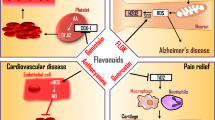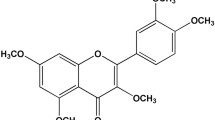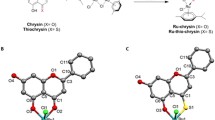Abstract
Flavonols are polyphenolic compounds with reported cardiovascular benefits and have been shown to exhibit antiplatelet properties in vitro. While some studies have shown inhibition of platelet aggregation following dietary supplementation with flavonol rich foods, few studies have assessed the ability of flavonols to inhibit platelet mediated thrombus generation in vivo. Furthermore, the duration of benefit and the influence of different dosing regimens remain unclear. In this study we investigate the ability of two structurally related flavonols; quercetin (Que) and 3′,4′-dihydroxyflavonol (DiOHF) to inhibit platelet aggregation, platelet granule exocytosis and vessel occlusion in a well characterized mouse model of platelet mediated arterial thrombosis. We investigated the effect of a single 6 mg/kg intravenous bolus and daily 6 mg/kg intraperitoneal doses over seven consecutive days. Carotid artery blood flow after injury was better maintained in mice treated with both Que and DiOHF when compared to the vehicle for both dosage regimens. This improved blood flow corresponded to inhibition of platelet aggregation and platelet dense granule exocytosis following chemical stimulation of PAR4. We therefore provide evidence of inhibition of platelet-mediated arterial thrombosis by flavonols in vivo, and demonstrate that this effect persists for at least 24 h after the last intraperitoneal dose. These data suggest a potential clinical role for flavonols as anti-platelet therapy.





Similar content being viewed by others
References
Michelson AD (2010) Antiplatelet therapies for the treatment of cardiovascular disease. Nat Rev Drug Discov 9(2):154–169
Willoughby S, Holmes A, Loscalzo J (2002) Platelets and cardiovascular disease. Eur J Cardiovasc Nurs 1(4):273–288
Anjaneyulu M, Chopra K (2004) Quercetin, an anti-oxidant bioflavonoid, attenuates diabetic nephropathy in rats. Clin Exp Pharmacol Physiol 31(4):244–248
Engler MB, Engler MM (2006) The emerging role of flavonoid-rich cocoa and chocolate in cardiovascular health and disease. Nutr Rev 64(3):109–118
McCullough ML, Peterson JJ, Patel R, Jacques PF, Shah R, Dwyer JT (2012) Flavonoid intake and cardiovascular disease mortality in a prospective cohort of US adults. Am J Clin Nutr 95(2):454–464
Geleijnse JM, Launer LJ, Van der Kuip DA, Hofman A, Witteman JC (2002) Inverse association of tea and flavonoid intakes with incident myocardial infarction: the Rotterdam Study. Am J Clin Nutr 75(5):880–886
Beretz A, Cazenave JP, Anton R (1982) Inhibition of aggregation and secretion of human platelets by quercetin and other flavonoids: structure-activity relationships. Agents Actions 12(3):382–387
Pietta PG (2000) Flavonoids as antioxidants. J Nat Prod 63(7):1035–1042
Rechner AR, Kroner C (2005) Anthocyanins and colonic metabolites of dietary polyphenols inhibit platelet function. Thromb Res 116(4):327–334
Hubbard GP, Wolffram S, Lovegrove JA, Gibbins JM (2004) Ingestion of quercetin inhibits platelet aggregation and essential components of the collagen-stimulated platelet activation pathway in humans. J Thromb Haemost 2(12):2138–2145
Chong MF, Macdonald R, Lovegrove JA (2010) Fruit polyphenols and CVD risk: a review of human intervention studies. Br J Nutr 104(Suppl 3):S28–S39
Vitseva O, Varghese S, Chakrabarti S, Folts JD, Freedman JE (2005) Grape seed and skin extracts inhibit platelet function and release of reactive oxygen intermediates. J Cardiovasc Pharmacol 46(4):445–451
Freedman JE, Parker C 3rd, Li L, Perlman JA, Frei B, Ivanov V, Deak LR, Iafrati MD, Folts JD (2001) Select flavonoids and whole juice from purple grapes inhibit platelet function and enhance nitric oxide release. Circulation 103(23):2792–2798
Briggs WH, Folts JD, Osman HE, Goldman IL (2001) Administration of raw onion inhibits platelet-mediated thrombosis in dogs. J Nutr 131(10):2619–2622
Jasuja R, Passam FH, Kennedy DR, Kim SH, van Hessem L, Lin L, Bowley SR, Joshi SS, Dilks JR, Furie B, Furie BC, Flaumenhaft R (2012) Protein disulfide isomerase inhibitors constitute a new class of antithrombotic agents. J Clin Invest 122(6):2104–2113
Perez-Vizcaino F, Duarte J (2010) Flavonols and cardiovascular disease. Mol Aspects Med 31(6):478–494
Duarte J, Perez-Vizcaino F, Zarzuelo A, Jimenez J, Tamargo J (1993) Vasodilator effects of quercetin in isolated rat vascular smooth muscle. Eur J Pharmacol 239(1–3):1–7
Perez-Vizcaino F, Ibarra M, Cogolludo AL, Duarte J, Zaragoza-Arnaez F, Moreno L, Lopez–Lopez G, Tamargo J (2002) Endothelium-independent vasodilator effects of the flavonoid quercetin and its methylated metabolites in rat conductance and resistance arteries. J Pharmacol Exp Ther 302(1):66–72
Woodman OL, Meeker WF, Boujaoude M (2005) Vasorelaxant and antioxidant activity of flavonols and flavones: structure-activity relationships. J Cardiovasc Pharmacol 46(3):302–309
Woodman OL, Chan E (2004) Vascular and anti-oxidant actions of flavonols and flavones. Clin Exp Pharmacol Physiol 31(11):786–790
Kim HY, Seok YM, Woodman OL, Williams SJ, Kim IK (2011) 3′,4′-Dihydroxyflavonol reduces vascular contraction through Ca(2 +) desensitization in permeabilized rat mesenteric artery. Naunyn Schmiedebergs Arch Pharmacol 385(2):191–202
Chan EC, Drummond GR, Woodman OL (2003) 3′,4′-dihydroxyflavonol enhances nitric oxide bioavailability and improves vascular function after ischemia and reperfusion injury in the rat. J Cardiovasc Pharmacol 42(6):727–735
Wang S, Thomas CJ, Dusting GJ, Woodman OL, May CN (2009) 3′,4′-Dihydroxyflavonol improves post-ischaemic coronary endothelial function following 7 days reperfusion in sheep. Eur J Pharmacol 624(1–3):31–37
Orlowski E, Chand R, Yip J, Wong C, Goschnick MW, Wright MD, Ashman LK, Jackson DE (2009) A platelet tetraspanin superfamily member, CD151, is required for regulation of thrombus growth and stability in vivo. J Thromb Haemost 7(12):2074–2084
Goschnick MW, Lau LM, Wee JL, Liu YS, Hogarth PM, Robb LM, Hickey MJ, Wright MD, Jackson DE (2006) Impaired “outside-in” integrin alphaIIbbeta3 signaling and thrombus stability in TSSC6-deficient mice. Blood 108(6):1911–1918
Linden MD, Frelinger AL 3rd, Barnard MR, Przyklenk K, Furman MI, Michelson AD (2004) Application of flow cytometry to platelet disorders. Semin Thromb Hemost 30(5):501–511
Kinlough-Rathbone RL, Packham MA, Reimers HJ, Cazenave JP, Mustard JF (1977) Mechanisms of platelet shape change, aggregation, and release induced by collagen, thrombin, or A23,187. J Lab Clin Med 90(4):707–719
Jackson SP (2007) The growing complexity of platelet aggregation. Blood 109(12):5087–5095
Woollard KJ, Sturgeon S, Chin-Dusting JP, Salem HH, Jackson SP (2009) Erythrocyte hemolysis and hemoglobin oxidation promote ferric chloride-induced vascular injury. J Biol Chem 284(19):13110–13118
Leo CH, Hart JL, Woodman OL (2011) 3′,4′-Dihydroxyflavonol reduces superoxide and improves nitric oxide function in diabetic rat mesenteric arteries. PLoS ONE 6(6):e20813
Schramm DD, Wang JF, Holt RR, Ensunsa JL, Gonsalves JL, Lazarus SA, Schmitz HH, German JB, Keen CL (2001) Chocolate procyanidins decrease the leukotriene-prostacyclin ratio in humans and human aortic endothelial cells. Am J Clin Nutr 73(1):36–40
Polagruto JA, Schramm DD, Wang-Polagruto JF, Lee L, Keen CL (2003) Effects of flavonoid-rich beverages on prostacyclin synthesis in humans and human aortic endothelial cells: association with ex vivo platelet function. J Med Food 6(4):301–308
Ishizawa K, Izawa-Ishizawa Y, Ohnishi S, Motobayashi Y, Kawazoe K, Hamano S, Tsuchiya K, Tomita S, Minakuchi K, Tamaki T (2009) Quercetin glucuronide inhibits cell migration and proliferation by platelet-derived growth factor in vascular smooth muscle cells. J Pharmacol Sci 109(2):257–264
Ren Q, Ye S, Whiteheart SW (2008) The platelet release reaction: just when you thought platelet secretion was simple. Curr Opin Hematol 15(5):537–541
Rinder CS, Student LA, Bonan JL, Rinder HM, Smith BR (1993) Aspirin does not inhibit adenosine diphosphate-induced platelet alpha-granule release. Blood 82(2):505–512
Italiano JE Jr, Richardson JL, Patel-Hett S, Battinelli E, Zaslavsky A, Short S, Ryeom S, Folkman J, Klement GL (2008) Angiogenesis is regulated by a novel mechanism: pro- and antiangiogenic proteins are organized into separate platelet alpha granules and differentially released. Blood 111(3):1227–1233
van Nispen tot Pannerden H, de Haas F, Geerts W, Posthuma G, van Dijk S, Heijnen HF (2010) The platelet interior revisited: electron tomography reveals tubular alpha-granule subtypes. Blood 116 (7):1147-1156
Radtke J, Linseisen J, Wolfram G (2002) Fasting plasma concentrations of selected flavonoids as markers of their ordinary dietary intake. Eur J Nutr 41(5):203–209
Siess MH, Vernevaut MF (1982) The influence of food flavonoids on the activity of some hepatic microsomal monooxygenases in rats. Food Chem Toxicol 20(6):883–886
Harwood M, Danielewska-Nikiel B, Borzelleca JF, Flamm GW, Williams GM, Lines TC (2007) A critical review of the data related to the safety of quercetin and lack of evidence of in vivo toxicity, including lack of genotoxic/carcinogenic properties. Food Chem Toxicol 45(11):2179–2205
Manach C, Williamson G, Morand C, Scalbert A, Remesy C (2005) Bioavailability and bioefficacy of polyphenols in humans. I. Review of 97 bioavailability studies. Am J Clin Nutr 81(1 suppl):230S–242S
Acknowledgments
The authors wish to gratefully acknowledge Dr Eunice Yang and Mr Musaed Alshahrani for their help with the animal model. Flow cytometry was performed at the RMIT University Flow Cytometry Core Facility.
Author information
Authors and Affiliations
Corresponding author
Electronic supplementary material
Below is the link to the electronic supplementary material.
Rights and permissions
About this article
Cite this article
Mosawy, S., Jackson, D.E., Woodman, O.L. et al. Treatment with quercetin and 3′,4′-dihydroxyflavonol inhibits platelet function and reduces thrombus formation in vivo. J Thromb Thrombolysis 36, 50–57 (2013). https://doi.org/10.1007/s11239-012-0827-2
Published:
Issue Date:
DOI: https://doi.org/10.1007/s11239-012-0827-2




